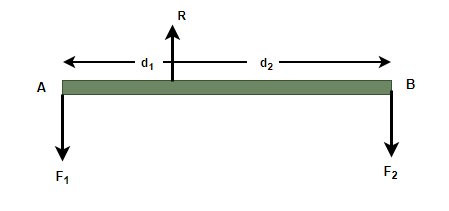The moment is the turning effect of a force. It is the product of the force ($F$) and the perpendicular distance between the pivot and the line of action of the force ($d$):
$$ \begin{equation}\begin{aligned} \text{moment} =F\times d\\ \end{aligned}\end{equation} $$Image Credits: Physics - I Can
The SI unit of moments is thus: $$ \begin{equation}\begin{aligned} \text{moment} &=F\times d\\ &\rightarrow N\times m\\ &=Nm\\ \end{aligned}\end{equation} $$
Q1: The moment of a force is itself a force.
- True
- False
The force that corresponds to the moment (the turning effect) is called the torque
The Principle of Moments
This states that, for a system in equilibrium, the sum of clockwise moments is equal to the sum of anti-clockwise moments.
Image Credits: Geeks for Geeks

Example: Find the weight of a plus-sized child that will cause him/her to balance a seesaw if a child of weight $105N$ is sitting on the other side at a distance of $3m$ from the pivot. The plus-sized child is at a distance of $1.5m$ away from the pivot.
Solution: We have:
- $F_1=105N$
- $d_1=3m$
- $d_2=1.5m$
What we need to find:
- $F_2$
Example: Determine if the following system is in equilibrium:
- On one side, there is a $4N$ object at a distance of $5m$ away from the pivot
- On the other side, there are two objects, one of $7N$ at a distance of $1.3m$ and the other of $3N$ at a distance of $1.4m$ away from the pivot.
Solution: For a system in equilibrium: $$ \begin{equation}\begin{aligned} \Sigma \text{anti-clockwise moments}&=\Sigma \text{clockwise moments}\\ 4N\times 5m&=7N\times 1.3m+3N\times 1.4m\\ 20Nm&=9.1Nm+4.2Nm\\ 20Nm&\neq 13.3Nm\\ \end{aligned}\end{equation} $$
Because the sum of moments on each side are unequal, the system is not equilibrium by the principle of moments.
$$ \begin{equation}\begin{aligned} 1hp&=\frac{33,000(ft-lb)}{1 min}\\ 1hp&=\frac{torque\times RPM}{5252}\\ \end{aligned}\end{equation} $$Couples
A couple is a pair of forces that only cause rotation. Recall that forces that cause translation and rotation. In order for a pair of forces to be considered as a couple, their translational effect must thus be zero. That is, they are equal and opposite.
Image Credits: Engineering at Alberta

Consider the pair of forces applied to a steering wheel. If the forces are equal and opposite but do not have the same line of action, then the translation of the steering wheel will be zero ($0$) and the rotation will be significant.
